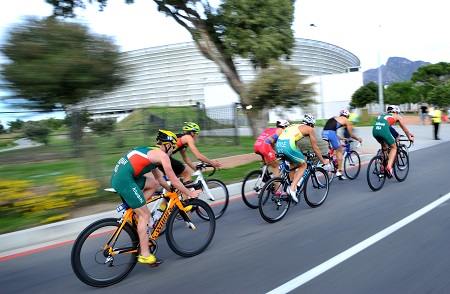Please click here to login into Discovery Digital Id
#WTSCapeTown equipment check

You’ve been strapping your face into your goggles, your head into your helmet, and your feet into your running shoes for several weeks now. You are probably starting to feel a little more confident about what you’re doing with your limbs; but how confident do you feel about your equipment?
The swim
For the Discovery World Triathlon Cape Town, you’re going to need a wetsuit. You will need to seek some expert advice on which wetsuit to buy and what size to get. Also invest in some wetsuit lubricant to reduce chafing.
Goggles are a necessity. Ideally, choose a pair with some UV protection for training and race day. Even though goggles are available in online stores, rather go buy a pair you can test out; they need to fit perfectly to avoid leaking. Again, you don’t need the most expensive brand; they just have to work.
Kit yourself out with a very recognisable towel. Not only does it serve as a place-marker, but it’s also a dry place to stand during transitions.
The cycle
You’re going to need a bike. If you’re taking part in your first triathlon, your old mountain bike will likely suffice. In fact, any bike will do. If you borrow a bike, make sure it fits you properly and that you train on it a few times. Be sure to take the bike to a good bike shop to get it serviced; it may need the bolts tightened, the tyres pumped, and the chain lubricated.
You’re also going to need a helmet. It doesn’t have to be expensive to do the job. It should be tested for safety and have a warranty to give you peace of mind.
A pair of sunglasses is essential. Aside from reducing glare, even a cheap pair of sunglasses – as long as they have UV protection – will help to protect your eyes from wind, stray insects, and sprays of water or rain.
They may not look very flattering, or feel great, but bike shorts with a good quality chamois – or pad – will make you so much more comfortable. Bike shorts help protect you from chafing and soften the ride a little. You might also consider a trisuit – an all-in-one outfit you can wear through every leg of the triathlon. They’re more comfortable than running in bike shorts but still offer some protection on the bike.
On the triathlon course, you have to be able to make any repairs to your bike that you need to. Make sure you have a flat kit – a small bag that fastens under your bike’s saddle – with everything to fix punctures, including a mini-pump, tubes, bombs (small cartridges of compressed air), tyre levers, and other kit.
When it comes to shoes, if you’re not used to, or can’t spare the expense for cleats; don’t. A basic pair of running shoes can serve for the cycle and the run, and will even save you time in the cycle to run transition.
Put a water bottle on your bike so that you can adequately hydrate during the cycle leg. You can even take it along for the run.
The run
You’ll need a hat. Whatever the weather, as long as it’s daylight there’s a risk that you’ll get sunburn. Take a hat with a peak to help protect your eyes as well.
The equipment you get for your first triathlon doesn’t have to be expensive; it just has to work. As you get more involved with triathlon, get more competitive, and enter more often, you can upgrade your equipment as you need to
